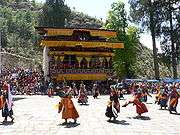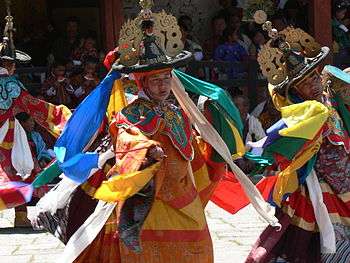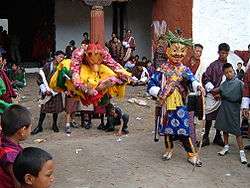Tshechu


Tshechu (Dzongkha: ཚེས་བཅུ།, literally "day ten") are annual religious Bhutanese festivals held in each district or dzongkhag of Bhutan on the tenth day of a month of the lunar Tibetan calendar. The month depends on the place. Tshechus are religious festivals of the Drukpa Lineage of the Kagyu school of Tibetan Buddhism.
Tshechus are large social gatherings, which perform the function of social bonding among people of remote and spread-out villages. Large markets also congregate at the fair locations, leading to brisk commerce.[1] The Thimphu tshechu and tha Paro tshechu are among the biggest of the tshechus in terms of participation and audience.
Tshechu traditions
The focal point of the tshechus are Cham dances. These costumed, masked dances typically are moral vignettes, or based on incidents from the life of the 9th century Nyingma teacher Padmasambhava and other saints.[1]
Most tshechus also feature the unfurling of a thongdrel - a large appliqué thangka typically depicting a seated Padmasambhava surrounded by holy beings, the mere viewing of which is said to cleanse the viewer of sin. The thongdrel is raised before dawn and rolled down by morning.
Because tshechus depend on the availability of masked dancers, registered dancers are subject to fine if they refuse to perform during festivals.[2]
History of Tshechus

Padmasambhava, the great scholar, visited Tibet and Bhutan in the 8th century and 9th century. He used to convert opponents of Buddhism by performing rites, reciting mantras and finally performing a dance of subjugation to conquer local spirits and gods. He visited Bhutan to aid the dying king Sindhu Raja. Padmasambhava performed a series of such dances in the Bumthang Valley to restore the health of the king. The grateful king helped spread Buddhism in Bhutan. Padmasambhava organized the first tshechu in Bumthang, where the eight manifestations of Padmasambhava were presented through eight forms of dances. These became the Cham dances depicting the glory of Padmasambhava.
Schedule

The dance schedule for each day of the four-day festival is set out and generally consists of the following dances.
- On the first day, the performances cover: Dance of the Four Stags (Sha Tsam); Dance of the Three kinds of Ging (Pelage Gingsum); Dance of the Heroes (Pacham), Dance of the Stags and Hounds (Shawo Shachi) and Dance with Guitar (Dranyeo Cham)
- On the second day the dances performed are: The Black Hat Dance (Shana), Dance of the 21 black hats with drums (Sha nga ngacham), Dance of the Noblemen and the Ladies (Pholeg Moleg), Dance of the Drums from Dramitse (Dramitse Ngacham), Dance of the Noblemen and the Ladies (Pholeg Moleg) and Dance of the Stag and Hounds (Shawa Shachi)
- On the third day, the dances performed are: Dance of the Lords of the Cremation Grounds (Durdag), Dance of the Terrifying Deities (Tungam) and Dance of the Rakshas and the Judgement of the Dead (Ragsha Mangcham)
- On the last day of the festival, the dances performed cover: Dance of Tamzhing Monastery in Jakar, Dance of the Lords of the Cremation grounds (the same dance as day 3), Dance of the Ging and Tsoling (Ging Dang Tsoling) and Dance of the Eight Manifestations of Padmasambhava (Guru Tshen Gye).
The last day of the four-day festival also marks the unfurling of the Thongdrel, a very large scroll painting or thangka, which is unfurled with intense religious fervour, early in the morning. This painting measuring 30 metres (98 ft)×45 metres (148 ft) has the images of Padmasambhava at the centre flanked by his two consorts and also his eight incarnations. Devotees who gather to witness this occasion offer obeisance in front of the Thongdrel seeking blessings. Folk dances are performed on the occasion. Before sunrise, the painting is rolled up and kept in the Dzong before it is displayed again one year later.[3]
List of tshechus
Below is a list of major tshechus in Bhutan, along with their 2011 dates. Dates in other years will vary.
| Date | Tsechu | Location |
|---|---|---|
| January 2–04 | Trongsa Tshechu | Trongsa |
| January 2–04 | Lhuntse Tshechu | Lhuntse |
| January 2–04 | Pemagatshel Tshechu | Pemagatshel |
| January 9 | Shingkhar Metochodpa | Bumthang |
| January 9–13 | Nabji Lhakhang Drup | Trongsa |
| February 10–15 | Punakha Dromache & Tshechu | Punakha |
| February 17–21 | Tangsibi Mani | Bumthang |
| February 18 | Chorten Kora | Trashiyangtse |
| February 18 | Tharpaling Thongdrol | Bumthang |
| February 19–21 | Buli Mani Chumey | Bumthang |
| February–March (1st month, 7th day) | Trashiyangtse Tsechu | Trashiyangtse |
| March 4 | Chorten Kora (2nd) | Trashiyangtse |
| March 13–15 | Gomkora | Trashigang |
| March 13–15 | Talo Tshechu | Talo, Punakha |
| March 13–16 | Zhemgang Tshechu | Zhemgang |
| March 15–19 | Paro Tshechu | Paro |
| March 17–19 | Chhukha Tshechu | Chukha |
| April 1–03 | Gaden Chodpa | Ura, Bumthang |
| May 12–14 | Domkhar Festival | Chhume, Bumthang |
| May 14–18 | Ura Yakchoe | Ura, Bumthang |
| June 19–21 | Padsel–Ling Kuchod | Bumthang |
| June | Laya Bumkhosa Festival (Bongkor) | Laya |
| July 8–10 | Nimalung Tshechu | Bumthang |
| July 9–10 does not move | Alpine | Ha, Haa |
| July 10 | Kurjey Tshechu | Bumthang |
| July 29 | Gangte Kurim | Gangte, Wangdue Phodrang |
| October 1–05 | Thimphu Drupchen | Thimphu |
| October 4–06 | Wangdue Tshechu | Wangdue Phodrang |
| October 4–06 | Gangte Drubchen & Tshechu | Gangte, Wangdue Phodrang |
| October 6–08 | Tamshingphala Choepa | Bumthang |
| October 6–08 | Gasa Tshechu | District Gasa |
| October 6–08 | Thimphu Tshechu | Thimphu |
| October 10–12 | Thangbi Mani | Bumthang |
| November 1–05 | Shingkhar Rabney | Ura, Bumthang |
| November 3–06 | Jakar Tshechu | Jakar, Bumthang |
| November 10–14 | Jambay Lakhang Drup | Bumthang |
| November 11–13 | Prakhar Duchoed | Bumthang |
| November 12 does not move | Black Necked Crane Festival | Gangte, Wangdue Phodrang |
| November 22–25 | Sumdrang Kangsol | Ura, Bumthang |
| December 2–05 | Trashigang Tshechu | Trashigang |
| December 2–05 | Mongar Tshechu | Mongar |
| December 3–04 | Tang Namkha Rabney Tang | Bumthang |
| December 10 | Singye Cham, Jambay Lhakhang | Bumthang |
| December 10–12 | Nalakhar Tshechu | Bumthang |
| December 10–13 | Chojam Rabney Tang | Bumthang |
In popular culture
The Bhutanese film Travellers and Magicians is set among a group of travellers, most of whom are going to the Thimphu tshechu.
See also
- List of Buddhist festivals
- Poya, similar concept in Sri Lanka however revolves around the cycle of the full moon of the lunar calendar
References
- 1 2 Dancing on the demon's back: the dramnyen dance and song of Bhutan, by Elaine Dobson, John Blacking Symposium: Music Culture and Society, Callaway Centre, University of Western Australia, July 2003
- ↑ Namgyal, Gembo (2010-10-28). "Reluctant Mask Dancers". Bhutan Observer online. Archived from the original on 2012-10-04. Retrieved 2012-01-28.
- ↑ Palin, pp. 269–270
- ↑ "Festival Dates". Windhorse Tours, Treks & Expeditions online. Retrieved 2011-07-26.